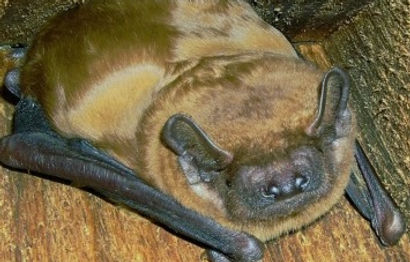
Recognition:

The largest Cornish bat, noctules are often active early in the evening and, with their long narrow wings, may be confused with swifts, as they fly fast and high above tree top level. Noctules are active hunters for larger beetles and moths and have been
recorded diving at speeds of 80 km/hr.
Noctules weigh up to 40 g (6 times the weight of a pipistrelle) and have a wing
span of as much as 450 mm. Their coat is a uniform golden brown, sometimes with a reddish tinge, and with the chest and belly being only a little lighter. The ears are short and broad and the tragus (the central ear lobe) is mushroom shaped. The face, ears and wings are dark. Males have conspicuous glands at the corner of the mouth producing a strongly smelling
white fatty material.
Noctules use a low frequency of 25 kHz to echolocate, so that their calls may be heard by children, or adults with good hearing. The pattern heard on a bat detector is a slow rhythmic ‘chip-chop’ alternating steep frequency modulation sweeps with short constant frequency calls. The loud call can be heard at long distances and allows the noctule to detect prey at long ranges in the open. When the bats are hunting closer to the ground they may use only the frequency modulation call.
Noctules roost almost exclusively in trees - using splits, holes, and rotted cavities, usually in mature deciduous trees or Scots pine. However, in Cornwall the largest recorded noctule roost is in a building! This woodland bat hunts high and fast, searching for larger moths and beetles, even eating cockchafers - a substantial meal.
Noctules emerge from their roosts at around dusk, and can sometimes be seen flying around streetlights. Noctules mate in the autumn and the females give birth to a single pup in June or July. Both sexes assemble in roosts on emerging from hibernation in March but the females return to the roosts where they were born by June.
Some bats may move between roosts, but in the same area, during the nursing phase, carrying their pup with them. Noctules may move roosts in order to reduce the build up of parasites within the roost. The small roost sites limit the number of individuals present: in the UK the average roost is only 14 bats, but in Europe they may exceed 100 animals. During the summer males roost in small groups, moving frequently, but in the autumn they establish breeding territories which are visited by females, sometimes in fairly large numbers. Males attract females using calls and a strong scent. It is possible that females are somewhat migratory, moving to warmer areas to hibernate in the winter. In eastern Europe noctules have been recorded migrating over 2500 km. Noctules hibernate in large mixed-sex groups, mainly using tree cavities, but also in buildings. This use of relatively poorly insulated tree roosts may result in significant mortality in very severe winters. On milder nights noctules may emerge from their hibernation roosts to forage.
Noctules are vulnerable to destruction of their roosting sites and also to the decline of insect prey from changes to agricultural practice and the use of pesticides. They have few natural predators although their remains have been found in pellets of both barn and tawny owls and there are records of them being taken by peregrines in Germany.
Norman the Noctule is Cornwall’s best known bat. Found on a garage floor in
Perranwell in 2007, Norman was malnourished and infested with mites. Although he was soon returned to health by the Bat Hospital he never could fly. So now he is a full time educational bat - giving everyone a chance to get up close and personal with bats, and even singing on cue to demonstrate the bat detector.
Tracks and Trails:
Noctule roosts in old trees are sometimes given away by the dark urine stains around the entrance and the accumulated droppings beneath. Large roosts are often noisy, especially in warm weather, when a shrill metallic chittering may be heard. Often insects swarm around the entrance to an occupied roost. The droppings are tubular, about 3 mm across and 15 mm long.

© Neil Reeves
© Paul McNie

Distribution:
Noctule bats are widespread along the central spine of Cornwall. They are found throughout England and southern Scotland, but absent from Ireland. Noctules occur across central and northern Europe and into north east Asia.
Records:
2007-2012: 141
2002-2007: 88
Pre-2001: 124
Total: 353
Did you know?:
The noctule’s dependence on tree cavities may bring it into conflict with holenesting birds, such as starlings. Noctules often use holes excavated by woodpeckers.
Conservation:
The noctule is a UK BAP priority species and considered vulnerable in the UK; it is at low risk of extinction over its range.
Survey Methods:
Monitoring of summer maternity roosts and hibernation roosts by licensed bat
workers. Mist net trapping by licensed bat workers. Emergence surveys. Bat detector monitoring. Cat kills and incidental reports.









